Through October and November 2017 and 2018, FIYAH hosted a survey on our website, inviting Black writers of speculative fiction to share their habits and experiences while on submission to short fiction markets for the preceding 12 months.
All writer-side data is self-reported and can be incomplete. Participation may have been limited by a number of factors including but not limited to awareness of the survey, desire to complete it, and failure to meet the stated requirements. Writers:
- must have submitted at least one piece of short speculative fiction to a paying market in the last 12 months. Speculative fiction includes fantasy, science fiction, horror, paranormal and all of their included subgenres. “Short” fiction includes shorts, novelettes, and novellas (under 40,000 words).
- must identify as Black or of the African Diaspora (to include mixed/biracial)
We do hope to increase the participation in future surveys by increasing the confidence Black writers have in submitting work regularly.
The study does not include sales that were made outside the survey window but published within it. The study may also reflect stories which were sold but have not yet published in a given market’s regular schedule.
“Study 1” is here defined as our analysis of 2016’s submissions. “Study 2” is the current iteration, examining the combined responses from the 2017 and 2018 surveys.
Survey Components:
Name: We collected the names of each participant to gauge any correlation between rejections or publication frequency and the “Blackness” or visibly ethnic nature of the writer’s name. The data provided indicated no correlation.
Country: The countries of residence for each participant were collected to gauge any potential bias against western/non-western voices. Respondents hailed from nine countries, not limited to Western nations, the Caribbean islands, and the African continent.
With what derivation of ‘Black’ do you personally identify?: Diaspora has created many different terms for Black identity, so we asked participants how they referred to themselves organically without structured pre-selection or multiple choice options. Over half of participants globally identified as “Black,” while 50% of U.S. respondents added that they also consider themselves “African-” or “Black American.” Mixed or multi-racial identifiers varied in expression as “mixed”, “biracial (specified)”, or with “Afro-” appended ethno-nationalities (“Afro-Asian American,” etc.).
Have you ever been published in a paying short fiction market?: 74% of respondents stated that they have been previously published, up from 64% in our 2016 study.
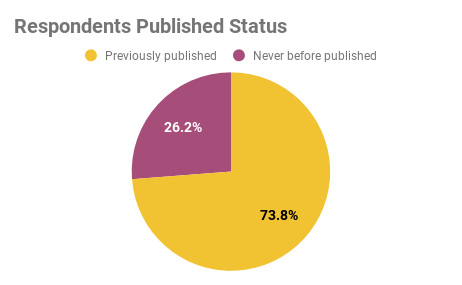
Do you self-identify racially/ethnically in your submissions?: This question was asked to establish any correlation between self-identifying and rejection/acceptance rates.
95% of respondents answered in the affirmative (they always self-identify or would if requested/if submitting to a limited demographic venue). This is a marked increase from our 2016 study, when 16.4% felt that self-identifying would be awkward or inappropriate.
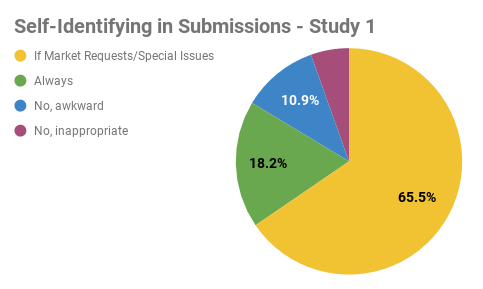
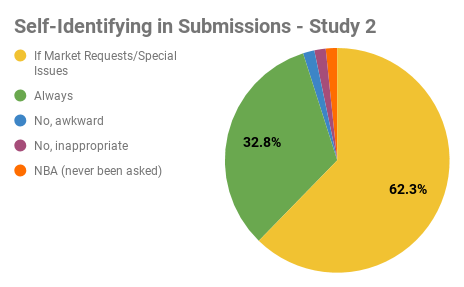
Where do you find your markets?: Participants were provided a selection of methods including word of mouth, submission portals (The Grinder, Ralan, Duotrope), author blogs, conferences, and “Other” (ie social media) and invited to select all the ways in which they find their markets. The majority of participants stated that they found their markets primarily through social media (34.5%) with the vast majority of those entries naming Twitter specifically. Social media is followed by “word of mouth” (20.8%) and The Grinder (12.8%).
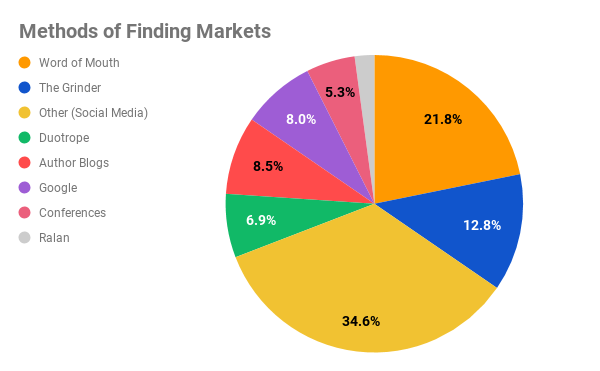
In the last 12 months, how many *different* stories have you submitted to paying short fiction markets?: 398 total submissions (352 unique stories) were made within the survey window, including those stories with submissions to more than one market, out of which 71 (20%) were sold. Respondents submitted an average of 6.5 stories to markets over a 13 month period.
Have you submitted work with more, less, or about the same frequency in the last 12 months as in other years?: We wanted to know if the number of stories submitted in the designated period was typical. 31% of participants marked a decrease in their usual submission frequency during the assigned period.
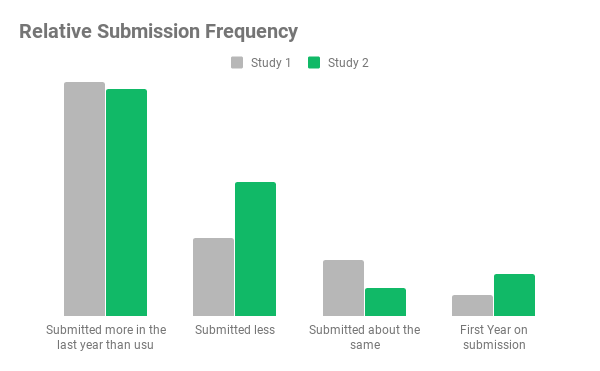
Has the publishing of statistics showing bias against black writers had an impact on your continued submission efforts? We wanted to gauge the psychological impact of Black writers reading reports revealing the apparent bias against them in publishing.
Responses showed a marked increase in writers either not being fazed (+6.9%) by statistical diversity analysis or feeling encouraged to submit (+9.4%). This indicates a subsiding shock and/or increased confidence that markets are at least paying attention.
Combined with the relative frequency submission question above, we can see that the discouragement did not always translate into abstaining or decreasing the participants’ submission numbers.

Submitted Markets: We provided participants a list of markets based on our list from 2016, with edits made to add debut markets and remove those that shuttered or went on hiatus in the relevant year. Respondents were also given additional space to write in unlisted markets to which they submitted work. Details on this breakdown can be found in our Market-Side Data.
Of your submissions in the last 12 months, how many markets resulted in sales?: 71 (+23) stories were sold to 26 (-7) markets. It is worth noting that 14 of these sales were to one-off anthologies. Details about this breakdown can be found in our Market-Side Data.
Average pay level of sales: For the purposes of this survey, we categorized PRO markets as those paying >$.06/word per SFWA guidelines. SEMI-PRO markets were those paying between <$.06/word but at least $.01/word. All markets paying a flat rate <$50 or <$.01/word were categorized as TOKEN markets. Respondents were published most frequently in PRO (40.8%) or TOKEN (36.7%) paying markets.

Reasons cited for rejection: Outside of form rejections, we provided space for those who received personalized rejections to tell us why they were told they were being rejected. Of the personalized rejections, the majority received messages that included verbiage citing mechanics (pacing, polish, structure) or that stories were well-written, well-liked, but “not for me.”
Is there anything else you would like us to know about your experience on submission? We allowed participants space to vent or expound on their experiences on submission in case we neglected a part of the study that was important to them. You can read the summation of these anecdotes (free of the participants’ identifying information) in our Anecdote Summary piece.

